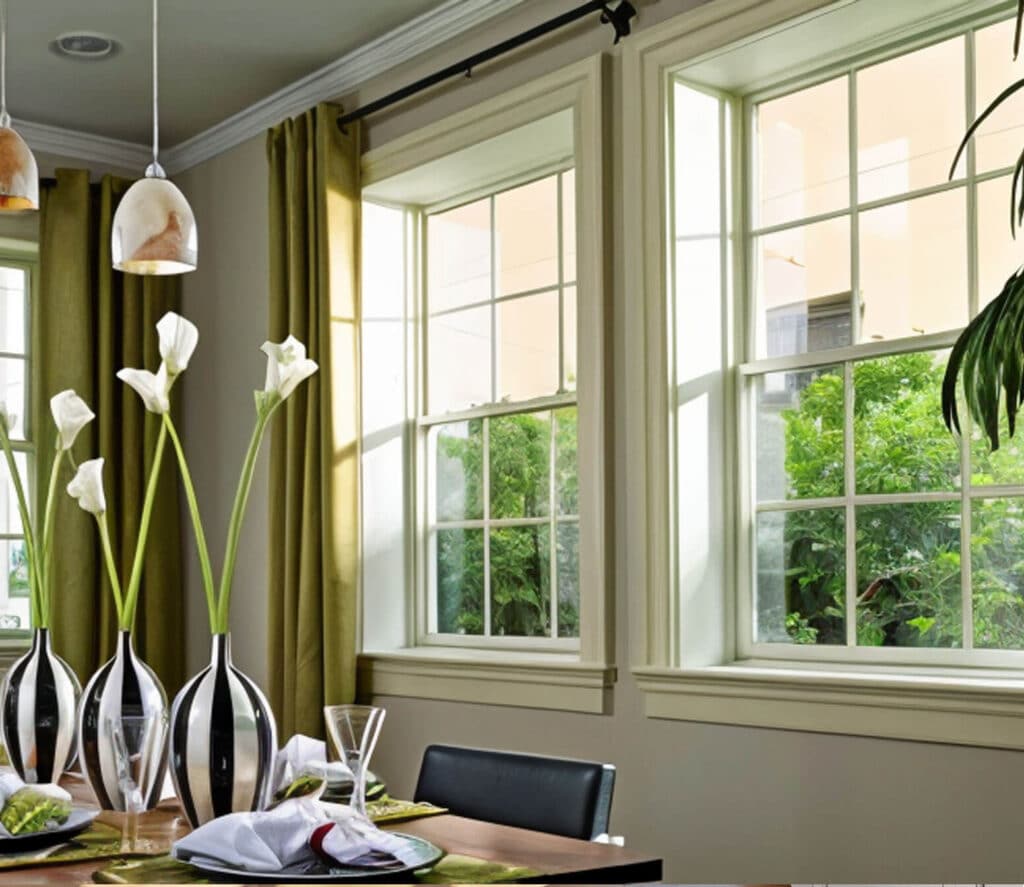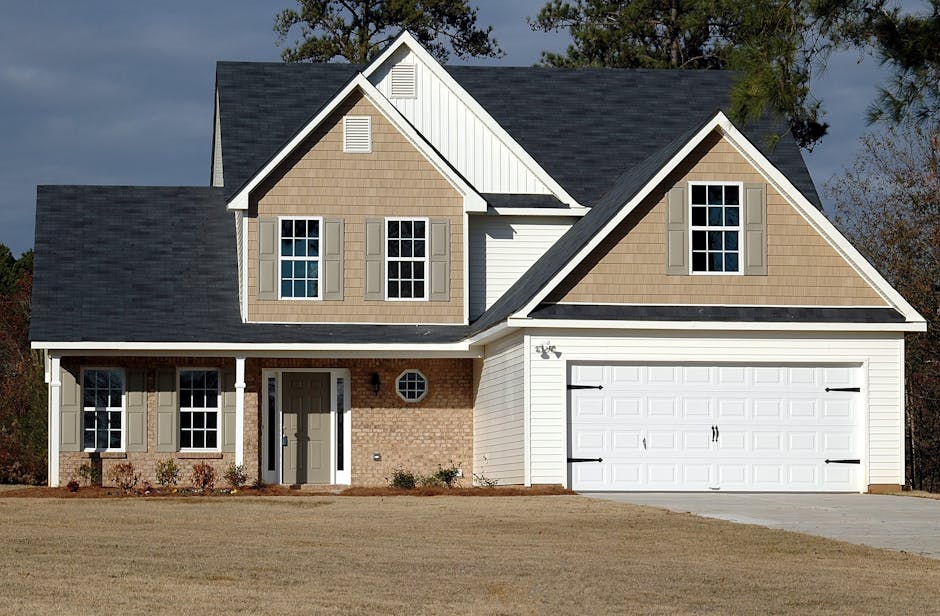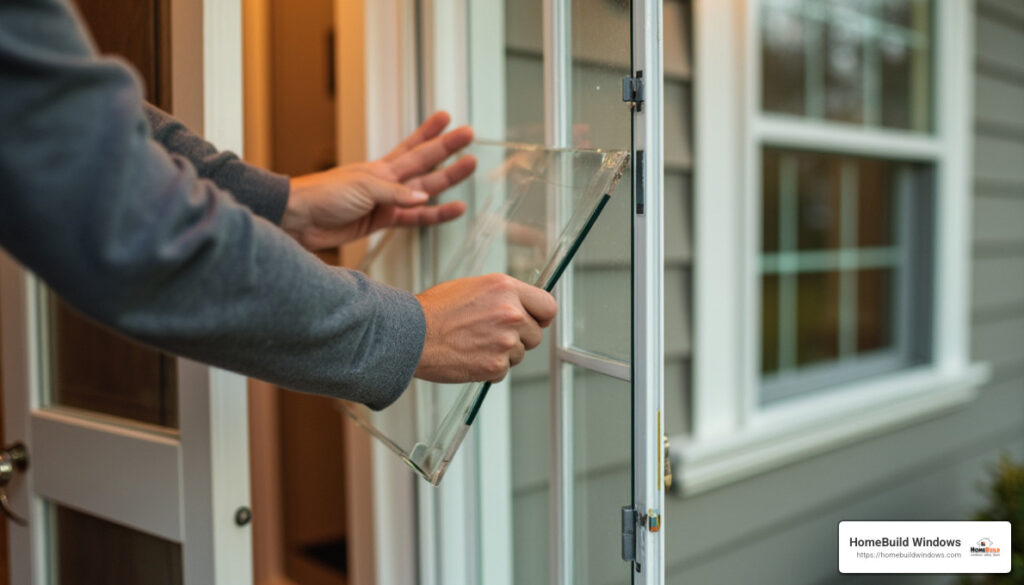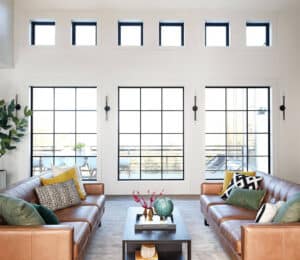Energy efficient glazing is more than just a stylish home upgrade; it’s a practical solution to common problems like heat loss, noise intrusion, and high energy bills. By trapping warmth indoors and blocking excessive outdoor noise, energy efficient glazing transforms your living space into a haven of comfort and tranquility. Here’s a quick rundown of why energy efficient glazing is a smart choice for homeowners:
- Improved Home Energy Efficiency: Keeps warmth inside during winter and cool air during summer, reducing the load on your HVAC system.
- Significant Cost Savings: Lower energy usage translates to reduced utility bills, making your investment worthwhile.
- Reduced Carbon Footprint: By consuming less energy, you contribute to environmental sustainability.
- Improved Home Comfort: Reduces outside noise and eliminates drafts, creating a more peaceful and comfortable home environment.
My name is Steve Mlynek, owner of HomeBuild Windows, where we specialize in providing energy efficient glazing solutions that stand the test of time. With years of experience, we understand the intricate details of window and door installations that improve both energy efficiency and curb appeal.

Understanding Energy Efficient Glazing
Energy efficient glazing isn’t just about adding an extra layer of glass to your windows. It’s a thoughtful approach to improving your home’s energy use, comfort, and even its value.
Types of Energy Efficient Glazing
Double Glazing and Triple Glazing
Think of double glazing as a sandwich of two glass panes with a gap in between. This gap acts as a barrier that reduces heat loss. Triple glazing takes it a step further with three panes, offering even better insulation. This extra pane can make a big difference, especially in colder climates where keeping the heat in is crucial.
Low-Emissivity (Low-E) Glass
Low-E glass is like a secret weapon for your windows. It has a special coating that reflects heat back into your home while still letting light in. This means you stay warm in the winter and cool in the summer without cranking up your heater or air conditioner.
Insulated Glazing Units
These units combine multiple panes of glass, often with a gas like argon or krypton between them. The gas adds an extra layer of insulation, making your home even more energy efficient. Plus, the units are sealed tight to keep the insulating gas in place.
Spectrally Selective Coatings
These coatings are designed to let in plenty of natural light while blocking out a significant amount of heat. It’s like wearing sunglasses that keep you cool.
Benefits of Energy Efficient Glazing
Thermal Insulation
With energy efficient glazing, your home stays cozy in the winter and refreshingly cool in the summer. This is because the glazing minimizes heat transfer, keeping your indoor temperature stable.
Noise Reduction
Tired of hearing the hustle and bustle outside? Energy efficient glazing can help. The multiple layers of glass and air or gas gaps act as a buffer, reducing noise levels and making your home a quieter place.

Condensation can be a real nuisance, leading to mold and mildew if not addressed. Energy efficient glazing reduces condensation by keeping the inner pane of glass warmer, which means less moisture buildup.
Energy efficient glazing is a smart investment that pays off in more ways than one. It’s all about creating a home that’s comfortable, quiet, and kind to your wallet and the planet. Next, let’s look at how to choose the right frame material to complement your new glazing.
Choosing the Right Frame Material
When it comes to energy efficient glazing, the frame material plays a crucial role in maximizing the benefits. Let’s explore the different options and see how they stack up.
Frame Material Comparisons
Vinyl Frames
Vinyl frames are popular for a reason. Made from polyvinyl chloride (PVC), they offer excellent thermal resistance, which helps keep your home warm in the winter and cool in the summer. They are also low-maintenance, as they don’t require painting and resist moisture. However, their environmental impact can be a concern, as PVC production involves chemicals that can be harmful to the environment.
Wood Frames
Wood frames bring a touch of elegance and warmth to any home. They provide good insulation but do require regular maintenance like sanding and repainting to keep them looking their best. Wood is a renewable resource, which makes it a more environmentally friendly option. However, the upkeep can be a downside for some homeowners.
Composite Frames
Composite frames are a blend of materials, often combining wood products with polymer plastics. This mix offers the best of both worlds: the structural and thermal properties of wood with improved moisture and decay resistance. They are stable and tend to have a lower environmental impact compared to pure vinyl frames. Plus, they require less maintenance than traditional wood frames.
Thermal Resistance, Maintenance, and Environmental Impact
| Frame Material | Thermal Resistance | Maintenance | Environmental Impact |
|---|---|---|---|
| Vinyl | High | Low | Moderate |
| Wood | Moderate | High | Low |
| Composite | High | Low to Moderate | Low |
Choosing the right frame material is about balancing your priorities. Whether you value thermal performance, ease of maintenance, or environmental responsibility, there’s a frame that fits your needs. Up next, we’ll dive into how gas fills and spacers further improve the energy efficiency of your glazing.
Gas Fills and Spacers in Energy Efficient Glazing
When it comes to energy efficient glazing, it’s not just about the glass and frames. The space between the glass panes can also make a big difference in how well your windows insulate your home. Let’s explore how gas fills and spacers contribute to this efficiency.
Argon and Krypton Gas Fills
In energy-efficient windows, argon and krypton gases are like unsung heroes. These inert gases fill the space between the panes of glass, acting as an insulator to reduce heat transfer.
-
Argon Gas is the most commonly used gas fill. It’s inexpensive and works well in the standard 1/2-inch space between window panes. Argon is clear, non-toxic, and odorless, making it a practical choice for most homes.
-
Krypton Gas, on the other hand, is used in situations where the space between panes is smaller, typically around 1/4 inch. It offers better thermal performance than argon but comes at a higher cost. Despite the price, krypton is a great option for those looking for the best insulation in tighter spaces.
Warm Edge Spacers
Spacers are the strips that separate the panes of glass in a window, and they play a key role in maintaining the efficiency of the gas fill. Traditional spacers were often made of metal, which conducts heat and can lead to energy loss.
Enter warm edge spacers. These are made from materials that conduct less heat, such as stainless steel or plastic. They help reduce the U-factor of the window, which is a measure of heat transfer. By lowering the U-factor, warm edge spacers help keep your home more comfortable and reduce condensation at the edges of the window.

Choosing the right combination of gas fills and spacers can significantly improve the insulation properties of your windows. This means not only a cozier home but also lower energy bills. Next, we’ll tackle some frequently asked questions about energy efficient glazing to help you make informed decisions.
Frequently Asked Questions about Energy Efficient Glazing
What is the most energy-efficient glazing?
When it comes to energy efficient glazing, triple-pane glass and low-e glass are top contenders. Triple-pane glass consists of three layers of glass with insulating gas in between. This setup significantly reduces heat transfer, making your home warmer in the winter and cooler in the summer.
Low-e glass is another excellent choice. It has a special coating that reflects heat back into your home while still allowing natural light to enter. This means less energy is needed to maintain a comfortable temperature inside.
Both options are highly effective, but your choice might depend on your specific needs and climate.
How does energy efficient glazing reduce energy bills?
Energy efficient glazing reduces energy bills by minimizing heat loss and improving insulation. Traditional windows can lose a lot of heat, causing your heating system to work harder. Low-e coatings reflect heat back into your home, while triple-pane glass adds extra layers of insulation.
This combination of features means your home stays warm with less energy, leading to lower heating bills. In fact, replacing single-pane windows with energy-efficient alternatives can save you hundreds of dollars per year on energy costs.
Is energy efficient glazing worth the investment?
Absolutely. Investing in energy efficient glazing can lead to substantial cost savings over time. Not only do you save on energy bills, but you also increase the value of your home. Homes with energy-efficient features are more attractive to buyers and can command higher prices.
Additionally, energy-efficient windows contribute to a more sustainable environment by reducing your carbon footprint. With energy costs on the rise, this investment becomes even more valuable.
In summary, energy efficient glazing offers a smart way to improve comfort, save money, and increase your home’s value. Next, we’ll explore the different frame materials to help you choose the best option for your windows.
Conclusion
Energy efficient glazing is more than just a smart home improvement; it’s a step towards a sustainable future. By investing in these advanced windows, you not only improve your home’s comfort and reduce energy bills, but you also contribute to an eco-friendly environment.
At HomeBuild Windows, we understand the importance of energy savings. That’s why we offer top-notch window replacement and installation services that focus on energy efficiency and durability. Our products, backed by a Pella Limited Lifetime Warranty, are designed to keep your home cozy while minimizing energy consumption.
Choosing energy efficient glazing can cut your heating and cooling costs significantly. With rising energy prices, this investment pays off by keeping more money in your pocket. Plus, homes with energy-efficient features often have a higher resale value, making it a wise financial decision.
Moreover, switching to energy-efficient windows reduces your carbon footprint. Less energy usage means fewer greenhouse gas emissions, which is a win for the planet.
In conclusion, whether you’re in Chicago or the surrounding suburbs, HomeBuild Windows is here to help you make the most of your home improvements. Accept energy efficient glazing and enjoy the benefits of a more sustainable and cost-effective home.
Ready to transform your home with energy efficient windows? Contact HomeBuild Windows today and find the clear benefits for yourself!




